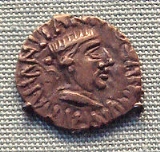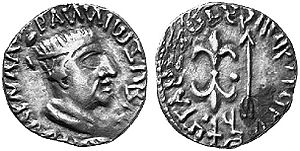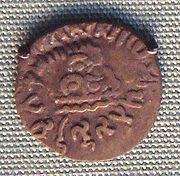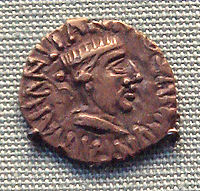
Nahapana
Encyclopedia
Nahapana was an important ruler of the Western Kshatrapas
, descendant of the Indo-Scythians
, in northwestern India. According to one of his coins, he was the son of Bhumaka
.
Nahapana is mentioned in the Periplus of the Erythraean Sea
under the name Nambanus, as ruler of the area around Barigaza:


 He also established the Kshatrapa coinage, in a style derived from Indo-Greek coinage. The obverse of the coins consists of the profile of the ruler, within a legend in Greek. The reverse represents a thunderbolt and an arrow, within Brahmi
He also established the Kshatrapa coinage, in a style derived from Indo-Greek coinage. The obverse of the coins consists of the profile of the ruler, within a legend in Greek. The reverse represents a thunderbolt and an arrow, within Brahmi
and Kharoshthi legends.
Nahapana is mentioned as a donator in inscriptions of numerous Buddhist caves in northern India. The Nasik and Karle inscriptions refer to Nahapana's dynastic name
(Kshaharata, for "Kshatrapa") but not to his ethnicity (Saka-Pahlava), which is known from other sources.
Nahapana had a son-in-law named Ushavadata (Sanskrit: Rishabhadatta
), whose inscriptions were incised in the Pandu-lena caves near Nasik. Ushavadata was son of Dinika and had married Dakshamitra, daughter of Nahapana. According to the inscriptions, Ushavadata accomplished various charities and conquests on behalf of his father-in-law. He constructed rest-houses, gardens and tanks at Bharukachchha (Broach
), Dashapura (Mandasor in Malva
), Govardhana (near Nasik) and Shorparaga (Sopara
in the Thana
district). He also campaigned in the north under the orders of Nahapana to rescue the Uttamabhadras
who had been attacked by the Malayas (Malavas
). He excavated a cave (one of Pandavleni Caves
) in the Trirashmi hill near Nasik and offered it to the Buddhist monks.
Numerous overstrikes are known of Nahapana coins by the powerful Satavahana
king Gautamiputra Satakarnifrom a Southern Gujarat hoard at Jogalthambi. However, it is not necessary that Gautamiputra Satakarni and Nahapana to be contemporaries since Satakarni mentions that the areas he has conquered were ruled by Ushavadata, rather than Nahapana.
Western Kshatrapas
The Western Satraps, Western Kshatrapas, or Kshaharatas were Saka rulers of the western and central part of India...
, descendant of the Indo-Scythians
Indo-Scythians
Indo-Scythians is a term used to refer to Sakas , who migrated into Bactria, Sogdiana, Arachosia, Gandhara, Kashmir, Punjab, Haryana, Uttar Pradesh, Gujarat, Maharashtra and Rajasthan, from the middle of the 2nd century BCE to the 4th century CE....
, in northwestern India. According to one of his coins, he was the son of Bhumaka
Bhumaka
Bhumaka was a Western Kshatrapa ruler of the early 2nd century CE.He was the father of the great ruler Nahapana, according to one of the latter's coins. He was preceded by Abhiraka , of whom a few coins are known....
.
History
The Kshatrapa dynasty became very powerful with the accession of Nahapana to the throne. Ksatrapa Bhumaka was succeeded by him who flourished about the period 60 CE. Jain Works are unanimous in that Nahapana ruled Ujjain for 40 years while the inscriptions made by Ushavadata evince that Nahapana ruled for 46 years. Thus, Nahapana must have captured Ujjain in his 6th regnal year. Periplus of 60 CE evince that Nahapana was ruling Ujjain, thus fixing his regnal period from around 54 CE to 100 CE. Nahapana managed however to build a strong power base in the west, occupying the traditional base of Satavahanas in Western Maharasthra.Nahapana is mentioned in the Periplus of the Erythraean Sea
Periplus of the Erythraean Sea
The Periplus of the Erythraean Sea or Periplus of the Red Sea is a Greco-Roman periplus, written in Greek, describing navigation and trading opportunities from Roman Egyptian ports like Berenice along the coast of the Red Sea, and others along Northeast Africa and India...
under the name Nambanus, as ruler of the area around Barigaza:
- "Beyond the gulf of BaracaGulf of KutchThe Gulf of Kutch is an inlet of the Arabian Sea along the west coast of India, in the state of Gujarat, and renowned for extreme daily tides .The maximum depth of Gulf of Kutch is ....
is that of BarygazaBharuchBharuch , also known as Broach, is the oldest city in Gujarat, situated at the mouth of the holy river Narmada. Bharuch is the administrative headquarters of Bharuch District and a municipality of more than 1,50,000 inhabitants. As Bharuch is a major seaport city, a number of trade activities have...
and the coast of the country of Ariaca, which is the beginning of the Kingdom of Nambanus and of all India. That part of it lying inland and adjoining Scythia is called AbiriaAbiriaAbiria was a region in Sindh, Pakistan described by Classical authors, mainly Ptolemy. It covers the area east of the Indus River Delta and is apparently named for the Abhira people, presumably in residence of the region....
, but the coast is called Syrastrene. It is a fertile country, yielding wheat and rice and sesame oil and clarified butter, cotton and the Indian cloths made therefrom, of the coarser sorts. Very many cattle are pastured there, and the men are of great stature and black in color. The metropolis of this country is MinnagaraMinnagaraMinnagara was an ancient port located in what is now the modern city of Karachi, in the Sindh province of Pakistan. Minnagara was a city of the Indo-Scythian kingdom, located on the Indus river in modern Pakistan, north of the coastal city of Barbaricum, or along the Narmada river, upstream of...
, from which much cotton cloth is brought down to Barygaza." Periplus, Chap. 41



Brāhmī script
Brāhmī is the modern name given to the oldest members of the Brahmic family of scripts. The best-known Brāhmī inscriptions are the rock-cut edicts of Ashoka in north-central India, dated to the 3rd century BCE. These are traditionally considered to be early known examples of Brāhmī writing...
and Kharoshthi legends.
Nahapana is mentioned as a donator in inscriptions of numerous Buddhist caves in northern India. The Nasik and Karle inscriptions refer to Nahapana's dynastic name
(Kshaharata, for "Kshatrapa") but not to his ethnicity (Saka-Pahlava), which is known from other sources.
Nahapana had a son-in-law named Ushavadata (Sanskrit: Rishabhadatta
Rishabhadatta
Rishabhadatta was viceroy of the Western Satrap ruler Nahapana, and his son-in-law.Ancient inscriptions were incised in the Pandu-lena caves near Nasik describing how Rishabhadatta was son of Dinika and had married Dakshamitra, daughter of Nahapana. According to the inscriptions, Ushavadata...
), whose inscriptions were incised in the Pandu-lena caves near Nasik. Ushavadata was son of Dinika and had married Dakshamitra, daughter of Nahapana. According to the inscriptions, Ushavadata accomplished various charities and conquests on behalf of his father-in-law. He constructed rest-houses, gardens and tanks at Bharukachchha (Broach
Broach
Broach may mean:* to raise a topic/subject for discussion*Broaching , a machining operation that uses a metalworking tool with a series of chisel points mounted on one piece of steel...
), Dashapura (Mandasor in Malva
Malva
Malva is a genus of about 25–30 species of herbaceous annual, biennial, and perennial plants in the family Malvaceae , one of several closely related genera in the family to bear the common English name mallow. The genus is widespread throughout the temperate, subtropical and tropical regions of...
), Govardhana (near Nasik) and Shorparaga (Sopara
Sopara
Sopara or Soparaka was an ancient port town and the capital of the ancient Aparanta. The site of this ancient town is located near the present day Nala Sopara town in the Thane district of the state Maharashtra, India.Nala Sopara is one of the busiest western suburbs of Mumbai city...
in the Thana
Thane
Thane , is a city in Maharashtra, India, part of the Mumbai Metropolitan Region, northeastern suburb of Mumbai at the head of the Thane Creek. It is the administrative headquarters of Thane district. On 16 April 1853, G.I.P...
district). He also campaigned in the north under the orders of Nahapana to rescue the Uttamabhadras
Uttamabhadras
The Uttamabhadras are an ancient Indian tribe described in the Mahabharata. They lived in the Punjab. Uttamabhadras originally were people of Balkh who had entered India in Vedic times. In Vedic times, they were closely related to Kurus and the Purus. In Kurukshetra war, we also find Madras...
who had been attacked by the Malayas (Malavas
Malavas
The Malavas were an ancient Indian tribe, which initially lived in the present-day Punjab province in Pakistan, later migrated to the present-day Eastern Rajasthan state in India and finally settled in the present-day North-western Madhya Pradesh state in India, which is known as Malwa after them....
). He excavated a cave (one of Pandavleni Caves
Pandavleni Caves
Pandav Leni, , are a group of 24 - 30, 1200-year-old Hinayana Buddhist caves. These were built by various Buddhist kings as homes for the saints. Most of the caves are Viharas except for the 18th cave which is a Chaitya...
) in the Trirashmi hill near Nasik and offered it to the Buddhist monks.
Numerous overstrikes are known of Nahapana coins by the powerful Satavahana
Satavahana
The Sātavāhana Empire or Andhra Empire, was a royal Indian dynasty based from Dharanikota and Amaravati in Andhra Pradesh as well as Junnar and Prathisthan in Maharashtra. The territory of the empire covered much of India from 230 BCE onward...
king Gautamiputra Satakarnifrom a Southern Gujarat hoard at Jogalthambi. However, it is not necessary that Gautamiputra Satakarni and Nahapana to be contemporaries since Satakarni mentions that the areas he has conquered were ruled by Ushavadata, rather than Nahapana.
External links
- History of the Andhras, by Durga Prasad, with numerous references to Nahapana.
- Coins of Nahapana
- More coins of Nahapana
- Coins with biography

